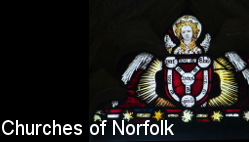
home I index I latest I glossary I introductions I e-mail I about this site
St Peter and St Paul, Carbrooke
Follow these journeys as they happen at Last Of England Twitter.
| St Peter
and St Paul, Carbrooke Carbrooke church is visible for
miles, standing on its ridge to the north-east of the town of Watton, a typical
example of a great East Anglian medieval church of which
there are several around here, for Saham Toney, Hingham
and Deopham are all close at hand, their prominent towers
also an adornment to this intensely agricultural Norfolk
landscape. The construction of the church unfolds,
broadly speaking, from east to west. The 14th Century
chancel, as large as some East Anglian churches on its
own, has striking east window tracery, a foil for the
grand late medieval tower with its curiously restrained
battlements at the other end of the church. An aisle and
a clerestory flank both sides of the nave. Carbrooke is a
sizeable village with its own school, but the church sits
above parkland and meadowland, ruling all it surveys. Separating the chancel from the nave are the remains of what must have been a fine late medieval screen. More unusual are the image niches arranged either side of the screen climbing up the chancel arch. At the very top of the arch is a curious painted board, as if it were a fire curtain waiting to descend. It appears to have three subjects painted on it, a large one flanked by two smaller ones. The immediate suggestion is that it was a royal arms, but the central image looks very much like the crossed keys and sword of St Peter and St Paul. Yet another unusual survival, and a much earlier one, is in the floor of the chancel. This is a pair of coffin slabs that date from the 13th Century and have the cross marks of the Knights Templars. The antiquarian Francis Blomefield deciphered their inscriptions as being for Roger de Clare and his mother, who founded an order of Hospitallers here in the the final decade of the 12th Century. The triumphant early 20th Century
scheme of glass by Powell & Sons would dominate a
smaller church. The incumbent here from 1927 until 1955
was George Chambers, known to his parishioners as Father
George. He set the parish on a course into the upper
spheres of Anglo-Catholicism, one tempered by his own
radical socialism. He memorably commissioned a
processional cross with a hammer and sickle on it! He was
a friend of the Bohemian artists John and Katin
Moray-Smith, who were based nearby in Norwich, and they
provided a number of sculptures and reliefs to Carbrooke,
the most endearing of which is the 1930s memorial at the
east end of the south aisle. It remembers Elizabeth
Chambers, the sister of Father George, and depicts a
young woman, willowy, with her clothes blown against her,
consorting with two deer in the style of St Francis. It
is set next to what was in those days no doubt a
flower-bedecked lady altar, but no trace of Carbrooke's
Anglo-Catholic past survives today. But still, a Latin
inscription commits her soul into the hands of God, and
continues with the beautiful words from Coleridge's Rime
of the Ancient Mariner: Simon Knott, June 2021 Follow these journeys as they happen at Last Of England Twitter. |
|
|||||||||||||||||||||||||||||||||||||||||||||||||||||||
|
|||||||||||||||||||||||||||||||||||||||||||||||||||||||
home I index I latest I introductions I e-mail I about
this site I glossary
Norwich I ruined churches I desktop backgrounds I round tower churches
links I small
print I www.simonknott.co.uk I www.suffolkchurches.co.uk